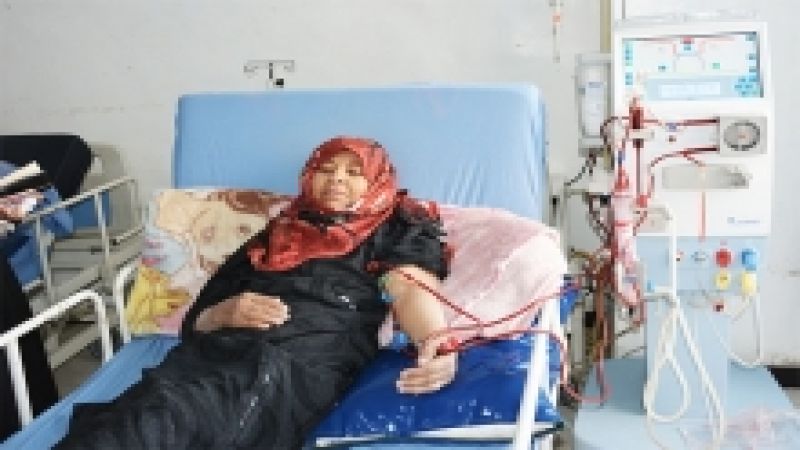
Local Editor
It takes Gailan Mohammed 2 hours on foot to reach Al-Jumhoori Hospital in Sana’a for haemodialysis sessions, simply because he cannot afford the cost of transportation.
“I barely have the strength to walk but I have to go to the hospital as I cannot endure the pain any longer,” said 28-year-old Gailan Mohammed, a renal failure patient who had to move from Taiz to Sana’a after the closure of the dialysis center in Taiz due to ongoing conflict.
“When I moved to Sana’a for treatment, I took shelter in a car garage in one of the most war-affected areas Faj Attan. I can’t afford to live anywhere else.”
Before the conflict, Gailan used to work, despite his illness, but he lost his job because he needed time off for dialysis sessions twice a week. “Fortunately the treatment is free of charge, otherwise I would have died a long time ago.”
Like Gailan, around 5200 patients with kidney failure across the country struggle to get dialysis sessions.
Long journey for treatment
Saoud Al Azani from Ibb is another patient coming to Sana’a specifically to receive hemodialysis treatment in Al Jumhoori Hospital. “My heart aches for my husband who has been psychologically ill since the beginning of the conflict. He has lost the ability to work and his treatment is costing us a fortune. I travel from Ibb to Sana’a every week for treatment. It is very exhausting, especially with my sickness, but we cannot afford to live in Sana’a.”
Living with kidney disease is never easy, with patients not only subjected to the pain of the disease, but also the constant worrying about the often overwhelming financial cost of treatment.
Unable to support his 9 children and elderly sick parents in his village, Abdulrahman Al Qudaimi from Haraz in Sana’a governorate explained with distress that he moved to Sana’a after he was diagnosed with renal failure almost 2 years ago, leaving his entire family behind.
“I have no one here to take care of me, I’m extremely sick and I cannot even walk because of the pain in my legs. But how can I afford to bring one of my sons here to help me, when I myself am staying with relatives because I can’t afford the cost of renting a place of my own?” he said wincing in pain.
Dialysis treatment is not only challenging for patients, but also for the dialysis centers that need regular funding to stay open. In Al Thawra hospital in Sana’a, over 200 dialysis sessions are provided per day, while Al Jumhoori hospital provides more than 70 sessions per day.
Dialysis centers have old machines that operate 24 hours a day and 7 days a week due to increasing number of patients across Yemen, the majority of whom have moved to the larger cities where treatment is available.
“One can’t imagine the suffering of renal failure patients having to settle with one or two dialysis sessions per week, when 3 times a week is what is needed for most cases,” said Dr Nevio Zagaria, WHO Representative in Yemen.
Dialysis centers burdened with new IDPs
Already congested with kidney failure patients, the dialysis center in Al-Thawra Hospital in Ibb has recently received new dialysis patients displaced from Hodeida. As the chairs in the center are fully occupied, new patients are forced to receive dialysis sessions in the old building using obsolete equipment.
“Even before the war in Hodeida, we could barely get dialysis sessions. Now, we have special dialysis sessions at night,” said Hamdan Ali, who also injured his leg while fleeing the war in Hodeida.
“In Hodeida, I was at least able to work for a few hours to save money for transportation to the dialysis centre, but now I’ve no money even to buy food for my family,” Hamdan added.
An estimated 5200 renal failure patients are at risk of death due to shortages of dialysis supplies that are not enough to provide the 700 000 dialysis sessions required per year. As the ongoing conflict continues to ravage the health situation, 4 of the country’s 32 dialysis centers have shut down, leaving the remaining centers in severe shortages of equipment and supplies, with a lot of cases to treat.
In 2017, WHO provided some of the dialysis supplies supporting 15 000 dialysis sessions in Sana’a and Hodeida. While this year, WHO has managed to provide medical supplies for 60 000 renal dialysis sessions during the past 2 months, distributed among the 32 dialysis centers across the country to cover the urgent need of more than 5000 patients. This has been an emergency measure due to the critical shortage of renal dialysis supplies.
In the meantime, WHO has made an international appeal to the private sector to make a special price for the dialysis medical supplies for Yemen due the humanitarian situation, in order to facilitate the huge procurement requirements for one year. We are very thankful for the extraordinary response of the private sector that allowed WHO to place orders to cover the medical supplies needed for 600 000 dialysis sessions across Yemen.
The overall support to renal dialysis centers has been possible thanks to the generous US$ 930 million grant from the King Salman Humanitarian Aid and Relief Centre and United Arab Emirates Aid to the UN 2018 Yemen Humanitarian Response Plan.
However, with the escalation of the conflict that is further deepening the catastrophic situation, the needs remain severe and what has been provided is never enough.
Source: News Agencies, Edited by Website Team